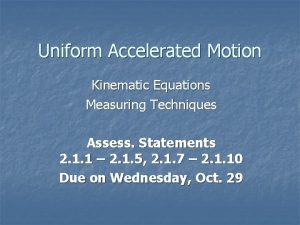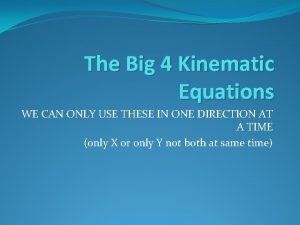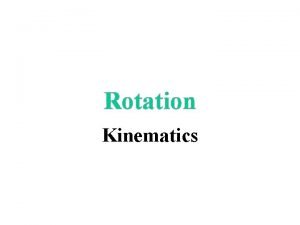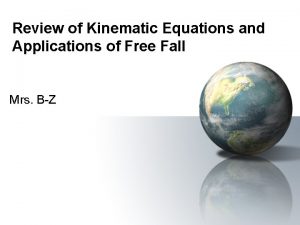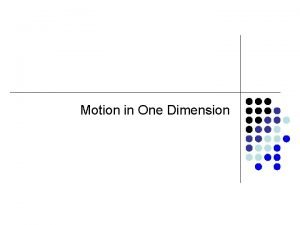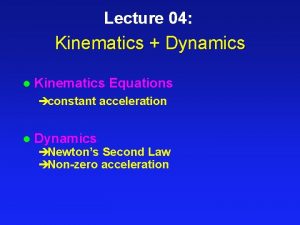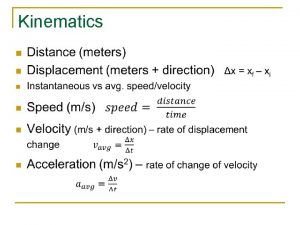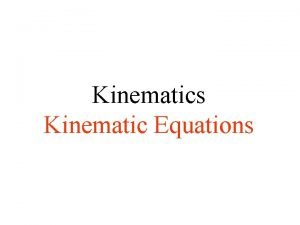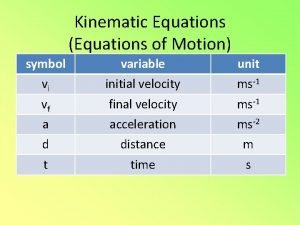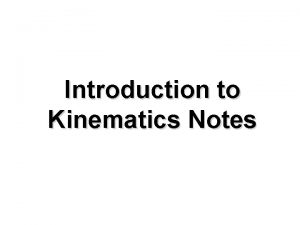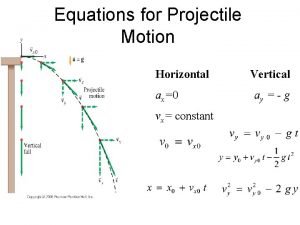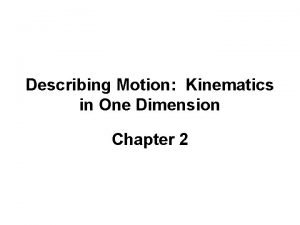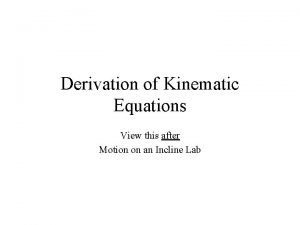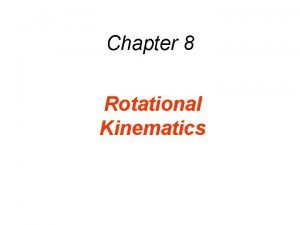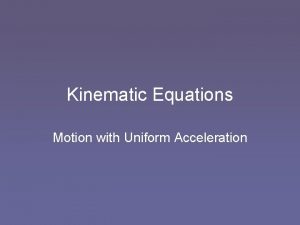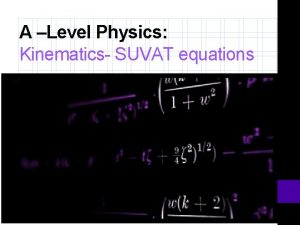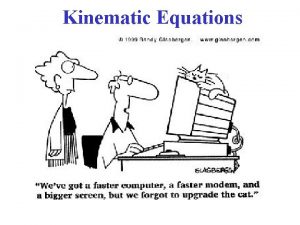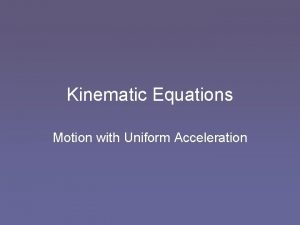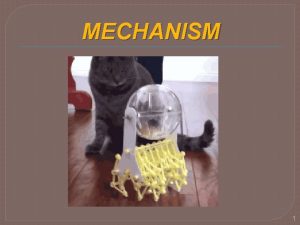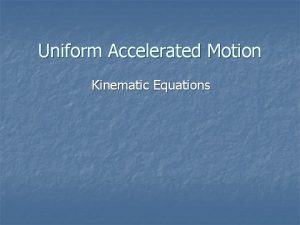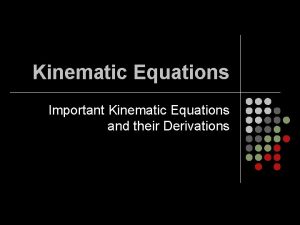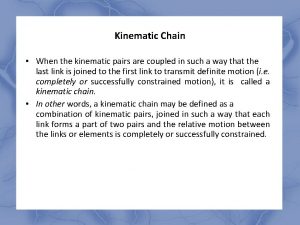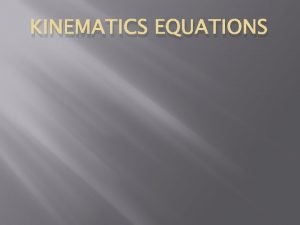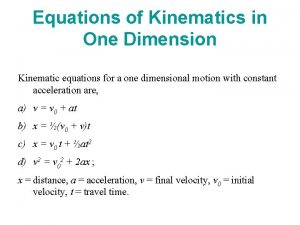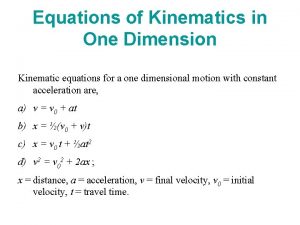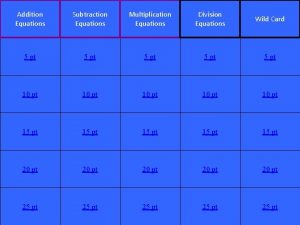Distance Acceleration Kinematic Equations Distance Acceleration Rate of



















- Slides: 19

Distance & Acceleration Kinematic Equations

Distance & Acceleration: Rate of change of velocity Measures how an objects velocity (or speed) is changing over time a = Change in velocity Change in time a = Δv Δt Units: m/s/s = m/s 2

Distance & Acceleration v acceleration is the slope of v – t graph Δv a = Δt Δv Δt t (+) a = increase in speed (-) a = decrease in speed {What does a = 0 mean? } (Constant Velocity!!)

Distance & Acceleration Ex. #1 A car travels from 2. 3 m/s to 15. 6 m/s over 14. 3 s. What is its average acceleration? a = Δv Δt 15. 6 – 2. 3 a = 14. 3 a = 0. 93 m/s 2

Distance & Acceleration Ex. #2 A bike slows down from 16 m/s to 1. 3 m/s while accelerating at – 1. 2 m/s 2. How long does this acceleration take? Δt = Δv a 1. 3 – 16 -1. 2 Δt = 12 s (Re-arrange the original equation)

Distance & Acceleration Ex. #3 An F 1 racing car can accelerate at – 12. 8 m/s 2 while slowing down for a curve. The car’s initial speed is 78 m/s and accelerates for 2. 3 s. What is the final speed of the F 1 car? v 2 = v 1 + at Re-arrange the equation (although it looks like a new one it really isn’t!! v 2 = 78 + (-12. 8 x 2. 3) v 2 = 49 m/s Substitution

Distance & Acceleration Case 1: Uniform Motion: What distance does a car go if it travels at a constant speed of 13 m/s for a time of 5. 0 s? Δt = 5. 0 s Δd v = 13 m/s Δd = v x Δt Δd = 13 x 5. 0 = 65 m

Distance & Acceleration • Recall Δd = (vave)(Δt) • If we set v 1 + v 2 = vave 2 • we obtain Δd = v 1 + v 2 2 Δt

Distance & Acceleration Case 2: Non-Uniform Motion: How far does the car travel while increasing its speed from 13 m/s to 21 m/s in 5. 0 s? Δt = 5. 0 s Δd v 2 = 21 m/s v 1 = 13 m/s In this case a new equation is needed. Δd = v 1 + v 2 2 Where: X Δt v 1 + v 2 2 = vave is the average speed.

Distance & Acceleration Δd = v 1 + v 2 X Δt 2 New equation. 13 + 21 Δd = 2 17 X 5. 0 Δd = 85 m X 5. 0 substitution The math. {Which is 20 m more than in case 1. }

Distance & Acceleration • If we now take v 2 = v 1 + aΔt and insert it into and simplify v 1 + v 2 Δd = • We get Δd = 2 v 1 Δt Δt + ½ a Δt 2

Distance & Acceleration Case 3: Non-Uniform Motion: How far does the car travel, starting from rest, and accelerating at 4. 5 m/s 2 in 5. 0 s? Δt = 5. 0 s Δd v 1 = 0 m/s In this case a new equation is needed. Δd = ½ at 2 Δd = ½ x 4. 5 m/s 2 x (5. 0 s)2 Δd = 56 m

Distance & Acceleration Case 4: Non-Uniform Motion: How far does a car go in 5. 0 s if the car has an initial velocity of 13 m/s and an acceleration of +1. 9 m/s 2? Δt = 5. 0 s Δd a = 1. 9 m/s 2 v = 13 m/s In this case another new equation is needed. Δd = v 1 x t + ½ x a x t 2 Note: A positive acceleration will increase distance while a negative acceleration will decrease distance.

Distance & Acceleration Δd = v 1 x t + ½ x a x t 2 13 x 5. 0 + ½ x 1. 9 x 5. 02 Δd = 65 + 23. 75 Δd = 89 m New equation. substitution The math.

Distance & Acceleration • If we now take v 2 = v 1 + aΔt and rearrange it v 2 - v 1 into Δt = a • And then sub into • We get Δd = v 22 – v 12 2 a v 1 + v 2 2 Δt

Distance & Acceleration Case 5: Non-Uniform Motion: (Landing a Jet Plane Video) How far does the car now go in while accelerating at 2. 6 m/s 2 while increasing its speed from 13 m/s to 35 m/s? Δd a = 2. 6 m/s 2 v 2= 35 m/s v 1 = 13 m/s Since there is no time in this problem another new equation is needed. Note: On some formula sheets: {v 22 = v 12 + 2 ad} To solve for distance: d = v 22 – v 12 2 a

Distance & Acceleration Δd = v 22 – v 12 New equation. 2 a 352 – 132 substitution 2 x 2. 6 (1225 – 169) 5. 2 The math.

Distance & Acceleration Δd = 1056 5. 2 203 m More math. Note: Use this equation when you are not given the time in the problem.

Distance & Acceleration • In summary, in addition to v 2 = v 1 + aΔt • We now have: v 1 + v 2 Δd = Δd Δt 2 v 1 Δt = + ½ a Δt 2 v 22 – v 12 2 a
 Kinematic equations rearranged
Kinematic equations rearranged Big 4 kinematic equations
Big 4 kinematic equations Rotation kinematic equations
Rotation kinematic equations Luke autbeloe drops a pile of roof shingles
Luke autbeloe drops a pile of roof shingles Big four kinematic equations
Big four kinematic equations Kinematic equaitons
Kinematic equaitons Third kinematic equation
Third kinematic equation Purpose of kinematic equations
Purpose of kinematic equations Kinematics symbols
Kinematics symbols Big three equations
Big three equations Projectile motion equations
Projectile motion equations Vf-vi=2a(xf-xi)
Vf-vi=2a(xf-xi) Time independent velocity equation
Time independent velocity equation Si unit of angular acceleration
Si unit of angular acceleration Kinematic equations for circular motion
Kinematic equations for circular motion Suvat equations a level
Suvat equations a level Projectile kinematic equations
Projectile kinematic equations What is centripetal acceleration
What is centripetal acceleration Angular velocity to linear velocity
Angular velocity to linear velocity Radial acceleration formula
Radial acceleration formula
